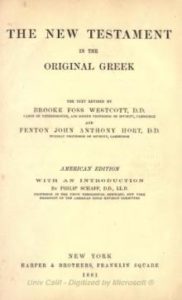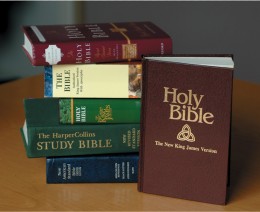 Brooke Foss Westcott (1825–1901) and Fenton John Anthony Hort (1828–1892) are mentioned regularly in relation to the Greek text of the NT. Naturally so because they were Greek textual scholars. Informally referred to as WH they produced the WH text of the New Testament. This translation in many ways was the precursor to the modern Critical Text underlying most modern translations.
Brooke Foss Westcott (1825–1901) and Fenton John Anthony Hort (1828–1892) are mentioned regularly in relation to the Greek text of the NT. Naturally so because they were Greek textual scholars. Informally referred to as WH they produced the WH text of the New Testament. This translation in many ways was the precursor to the modern Critical Text underlying most modern translations.
The following brief comments are not meant to stand alone, please use the links that follow that will enlarge, reinforce, and add to the article.
Some Background
After the flurry of translations leading up to the King James Version (when many translations were produced such as Wycliffe’s, Tyndale’s, Coverdale’s, The Bishops Bible, The Geneva Bible etc), a steady trickle of translations continued. The KJV translators only had fewer than 12 manuscripts of the NT in Greek to work with. In fact they had no Greek at all for part of the book of Revelation so they had to ‘conjecturally amend’ (make a best guess) what the section actually said. The KJV itself went through a number of revisions and the one we use today is usually the 1769 revision.
More Manuscripts and Understanding
As time progressed more and earlier manuscripts came to light which have helped us to hone the text of the New Testament so that today it stands without equal among the works of antiquity in the number of witnesses and quality of its manuscript evidence. Today, for instance, we have in excess of 5600 manuscripts we can consult.
We know now that the Greek of the New Testament was ‘common’ or koine Greek which was the Greek of Alexander the Great, a common, or marketplace Greek. The KJV translators did not know this and sometimes mistranslated words because of this lack of understanding. This knowledge also informs us that the New Testament was not written generally in ‘posh’ language more a sort of ‘popular tabloid’ type language. We can conclude that any modern translation that uses majestic, literary or grand language is not generally reflecting the text and style of the Greek manuscripts of the New Testament.
A Better Text?
This is where WH come in, they compiled manuscripts , examined them and took note of the earliest and best of them and compiled a printed text, the Westcott & Hort text. This, like Erasmus in the 1500s, summarised the best information available to produce the most accurate text. The Revised Version of the KJV, published in 1881, reflects this increased knowledge. It kept the KJV style language but was much more accurate. Since WH, further discoveries and knowledge have meant the ‘eclectic’ text we have now is even more accurate than back then.
But Weren’t They Unbelievers/Arians/Antichrist/Catholics etc
These charges are often brought in a bid to discredit the Westcott & Hort text. In one sense it matters not. If we investigated the translators of the KJV we may be surprised at what we would find. Westcott & Hort were scholars and were ‘peer’ tested by many others.
The text today is not the WH text; things have moved on. However there are similarities because the improvement in scholarship from the mid 19th century on benefited WH and modern critical texts (critical is not a negative thing it refers to the detail and analysis that has gone into producing it). I have provided a link to a website that answers some of the more preposterous allegations against WH.
Views That are Not Credible Today.
1. Believing that the KJV is the ‘Gold Standard’ or even worse ‘the Word of God’
The KJV is a translation like all others. No English translation is ‘inspired’. The KJV is not useful for two reasons:
1. It is inaccurate in many ways now due to greater understanding and the number of manuscripts that make better translations possible
2. The archaic language detracts from its use and understandability. The debate in the link below between White and Moorman shows how the King James Version Only view simply doesn’t stand up and has no intellectual credibility at all.
2. To prefer the KJV because the Trinity (or any other doctrine) can be proved more easily from it.
To start with a doctrine and then ‘correct’ or prefer a Bible translation because of it is, frankly, the wrong way around!! So in modern, more reliable, translations we ‘lose’ 1 John 5:7 ‘…..these three are one” ( not in any Greek NT manuscript before 1500) and 1 Tim 3:16 ‘God manifest in the flesh’. (weak textual evidence). However we ‘gain’ John 1:18 ‘God the only Son’; Titus 2:13 and 2 Pet 1:1 ‘God and Saviour’ ( neither in KJV) and ‘very nature God’ in Php 2:6. I have used the NIV for comparison.
We still observe people using 1 John 5:7 to ‘prove’ the Trinity. It simply isn’t intellectually credible and will be unpersuasive, and rightly so, for an educated cultist. You will note it is not included in almost all modern translations. Further, if we cannot demonstrate the Trinity without this one verse we need to learn to be better Bible students. It is unwise to use these KJV verses in apologetics due to the very clear textual evidence against them, evidence well known to Jehovah’s Witnesses.
3. To prefer the TR (Textus Receptus) against modern critical Greek texts.
The TR was the critical text of its day, there is no reason to think that God ‘froze in time’ the text of that period. Much has happened since then, including the discovery of 5000+ Greek manuscripts of the New Testament and, of course, the Dead Sea Scrolls! To ignore these developments is to switch off our brains; now, we don’t want to do that do we? An excellent link below explores this issue in more depth.
4. To use the KJV as a baseline so that anything different to it is ‘changing the word of God’.
This is similar to ‘1’ but not exactly the same. I often see people pointing to Acts 8:37 and other passages as an example and pointing out how that verse is not in modern versions.
The baseline is not the KJV, it wasn’t even the first (by a long way) of the English translations of the Bible. In his excellent history of the KJV, Gordon Campbell points out that the Geneva Bible, which preceded the KJV was used ‘long after the KJV had been published’ by such notaries as Lancelot Andrewes, Richard Hooker, John Whitgift, and William Laud (Bible, p. 27, Oxford University Press, 2010)
The ‘baseline’ is the original Greek and Hebrew, so what we compare all versions to is the best text we can produce, not our favourite translation. Once we understand that we become aware of some of the shortcomings of the KJV. Translations are not based on the previous translation and ‘revised,’ which is the claim of Mormons for instance, they are based on the manuscripts available, this is an important point to understand.
It’s all ‘Byzantine’ to me…..
There are a number of theories about text types and families which have some intellectual and academic credibility. I have never personally come across anyone that actually believes it, but some scholars do. There are various groupings of texts, according to this thinking, and one of them is of mainly later texts after the fall of Antioch and Alexandria to Islam. This text type is called ‘Byzantine’ and most of its copies can be sourced to Constantinople.
This Byzantine text is not the textus receptus, as it is thought to be by some, it is not the basis for the KJV, it doesn’t include 1 John 5:7 or the end of Mark, but it is established by many manuscripts. Almost all the websites, articles, films, videos and messages I have come across regarding the KJV, or anti modern versions, pay no attention at all to this viewpoint as they seem more concerned about showing that a translation 400 years old is in some way better than the ones we have today.
Some Final Comments.
 To hold to varying forms of King James Only or Textus Receptus Only has caused great harm to the Christian Church; it confuses people. Many modern versions like the New International Version (450 million copies worldwide), English Standard Version, Holman Christian Standard Bible, New Living Translation, New Century Version, Amplified Bible, New English Translation and New American Standard Bible have been produced by the finest Bible believing scholars in the world. They have dedicated themselves to learn Hebrew, Greek and Aramaic, they have studied for decades the available manuscripts and have produced these translations as the fruit of their learning, humbly submitting themselves to Christ as they do it.
To hold to varying forms of King James Only or Textus Receptus Only has caused great harm to the Christian Church; it confuses people. Many modern versions like the New International Version (450 million copies worldwide), English Standard Version, Holman Christian Standard Bible, New Living Translation, New Century Version, Amplified Bible, New English Translation and New American Standard Bible have been produced by the finest Bible believing scholars in the world. They have dedicated themselves to learn Hebrew, Greek and Aramaic, they have studied for decades the available manuscripts and have produced these translations as the fruit of their learning, humbly submitting themselves to Christ as they do it.
Other translations such as the New Revised Standard Version, New English Bible, Contemporary English Version and Jerusalem Bible also include Evangelical, Bible-believing scholars and many others all of whom have the highest academic credibility. We can trust these, understand and appreciate the differences, but we would be foolish to ignore them or condemn the translators as the spawn of Satan or Lucifer’s dupes as I have read on occasion.
Using the KJV/Textus Receptus line (or its variants) makes us look foolish (not fools for Christ, just fools!) in front of those who oppose historic Christianity and know the facts. They will leave discussions with us ‘knowing’ we will not face up to the facts available in the manuscripts. I once saw a ‘Christian’ rant and rave to some Jehovah’s Witnesses and he quoted 1 John 5:7, 1 Tim 3:16 and said the KJV was the true Word of God, it was embarrassing and it reinforced the Witnesses in their faith. I urge you not to do this. The links below give us plenty of information to add detail to my brief comments.
God’s Gracious Provision
God has been gracious to us in that when there were voices contesting the authenticity of the OT record the ‘dead sea scrolls’ were discovered. When voices started saying that the Gospel of John was a much later ‘invention’ (as late as 200AD) we discovered papyrus fragment p.52 dated at probably 115AD from almost as soon as the ink was dry on the original!! We dare not and must not ignore these things. We have nothing to fear from new manuscript discoveries and the advancement of linguistic knowledge. Westcott & Hort in their day, and others from that period, as well as scholars today, serve us and God well in what they provide.
The KJV was a superb translation for its day. The translation now is a literary masterpiece. No Christian truth is affected by any of the variations of translation due to textual differences. What I write here is not an attack on the KJV it is an attempt to show how God continues to give us more knowledge and information which we must value and appreciate.
_______________________________________________
A site defending Westcott and Hort against unnecessary and incorrect attacks.
Some things most people do not know about the KJV.
http://newlife.id.au/church-history/7-things-about-the-king-james-bible/
Information about the KJV translators.
http://kingjamesbibletranslators.org/bios/
An examination of the 16th century critical text ‘the textus receptus’ v the Westcott and Hort 19th century Critical text.
http://www.bible-researcher.com/kutilek1.html
A series of articles on relevant topics about the KJV and Greek text.
http://www.kjvonly.org/doug/index_doug.html
A superb debate between two Bible teachers one ‘defending the KJV’ chaired by Doug Harris, founder of Reachout

